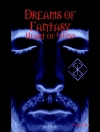The Curious Case of Benjamin Button (1922) is a short story by F. Scott Fitzgerald. Published at the beginning of Fitzgerald’s career as a leading writer of American fiction, The Curious Case of Benjamin Button appeared in the May 27, 1922 edition of Collier’s. In 2008, the story was adapted into a blockbuster film starring Brad Pitt, Cate Blanchett, and Taraji P. Henson. In the city of Baltimore, Benjamin Button is born with a mysterious condition that gives him the appearance and intellect of a 70-year-old man. As a child, he suffers from misunderstanding and loneliness, and following his rejection from Yale College at the age of 18, he returns home to run his father’s hardware store. Now appearing as a 50-year-old, he falls in love with Hildegarde Moncrief, the young daughter of a decorated general. The two marry, but as Benjamin grows younger he begins to dream of a life away from an aging wife and the boredoms of domesticity. In 1898, he enlists in the Spanish-American War and embarks on an eventful military career. When he returns home to his wife and business, he finds himself restless once more, longing again for the freedom and excitement of a youth he was denied. The Curious Case of Benjamin Button is a story of fantasy and romance that illuminates the dignities and indignities of aging while raising valuable questions about the normal trajectory of life for modern Americans. With a beautifully designed cover and professionally typeset manuscript, this new edition of F. Scott Fitzgerald’s The Curious Case of Benjamin Button is a classic work of American literature reimagined for modern readers.
Since our inception in 2020, Mint Editions has kept sustainability and innovation at the forefront of our mission. Each and every Mint Edition title gets a fresh, professionally typeset manuscript and a dazzling new cover, all while maintaining the integrity of the original book.
With thousands of titles in our collection, we aim to spotlight diverse public domain works to help them find modern audiences. Mint Editions celebrates a breadth of literary works, curated from both canonical and overlooked classics from writers around the globe.
Об авторе
F. Scott Fitzgerald (1896-1940) was an American novelist, essayist, and short-story writer. Born in St. Paul, Minnesota to Edward and Mary Fitzgerald, he was raised in Buffalo in a middle-class Catholic family. Fitzgerald excelled in school from a young age and was known as an active and curious student, primarily of literature. In 1908 the family returned to St. Paul, where Fitzgerald published his first work of fiction, a detective story, at the age of 13. He completed his high school education at the Newman School in New Jersey before enrolling at Princeton University. In 1917, reeling from an ill-fated relationship and waning in his academic pursuits, Fitzgerald dropped out of Princeton to join the Army. While stationed in Alabama, he began a relationship with Zelda Sayre, a Montgomery socialite. In 1919, he moved to New York City, where he struggled to launch his career as a writer. His first novel, This Side of Paradise (1920), was a resounding success, earning Fitzgerald a sustainable income and allowing him to marry Zelda. Following the birth of his daughter Scottie in 1921, Fitzgerald published his second novel, The Beautiful and the Damned (1922), and Tales of the Jazz Age (1922), a collection of short stories. His rising reputation in New York’s social and literary scenes coincided with a growing struggle with alcoholism and the deterioration of Zelda’s mental health. Despite this, Fitzgerald managed to complete his masterpiece The Great Gatsby (1925), a withering portrait of corruption and decay at the heart of American society. After living for several years in France in Italy, the end of the decade marked the decline of Fitzgerald’s reputation as a writer, forcing him to move to Hollywood in pursuit of work as a screenwriter. His alcoholism accelerated in these last years, leading to severe heart problems and eventually his death at the age of 44. By this time, he was virtually forgotten by the public, but critical reappraisal and his influence on such writers as Ernest Hemingway, J.D. Salinger, and Richard Yates would ensure his status as one of the greatest figures in twentieth-century American fiction.












